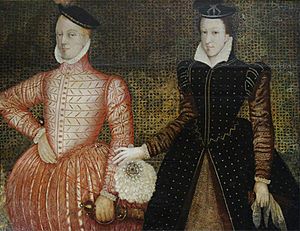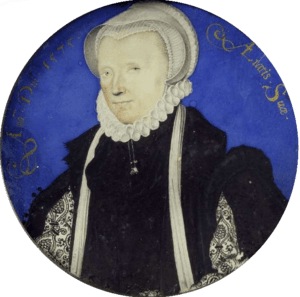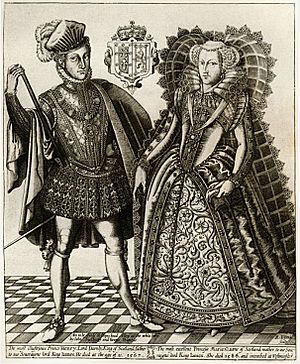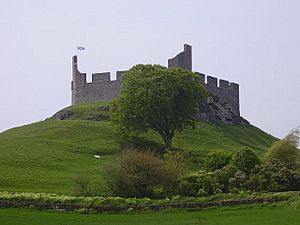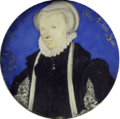Wedding of Mary, Queen of Scots, and Henry, Lord Darnley facts for kids
Mary, Queen of Scots, and Henry Stuart, Lord Darnley, got married at the Palace of Holyroodhouse on 29 July 1565. Mary was 22 years old, and Darnley was 18 or 19. This was a very important event in Scottish history.
Contents
Who Were Mary and Darnley?
Mary, Queen of Scots, had been married before to Francis II of France. After he died, she came back to Scotland in September 1561 to rule the country herself.
Henry Stuart, Lord Darnley, grew up in England. He was the son of Matthew Stewart, 4th Earl of Lennox and Margaret Douglas. He was also a grandson of Margaret Tudor, which made him a cousin to Mary. Darnley came to Scotland and met Mary at Wemyss Castle in February 1565.
Elizabeth I, the Queen of England, had suggested Mary marry an English nobleman, Robert Dudley, 1st Earl of Leicester. But when it became clear Mary wanted to marry Darnley, Elizabeth was not happy. She asked Darnley and his father to return to England. Darnley's mother, Lady Margaret Douglas, was even sent to the Tower of London.
Darnley's New Titles
Before the wedding, Darnley received several important titles. He was made a knight, Lord of Ardmanoch, and Earl of Ross at Stirling Castle on 15 May 1565. About 15 men were also made knights that day.
A week before the wedding, on 22 July, Darnley was made Duke of Albany at Holyrood Abbey. The day before the wedding, on 28 July, he was officially announced as the King of Scotland.
Getting Ready at Holyrood Palace
Mary's records show some of the preparations at Holyrood Palace for the wedding. Servais de Condé, who managed Mary's clothes and household, decorated the chapel. He used red velvet for the altar and special cushions for the couple to kneel on. The wedding happened in the palace chapel, which is no longer there today.
Extra seats were added in the queen's room. These included folding stools and low stools covered in red velvet. These stools were old and had belonged to Mary's parents. Mary's bedroom, where she changed clothes, is still part of the palace today. Special clothes were made for Darnley and his helpers.
The Wedding Ceremony
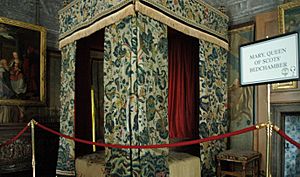
The wedding ceremony was led by John Sinclair. We know many details from a report written by an English diplomat, Thomas Randolph.
Mary went to the palace chapel early in the morning. She wore black mourning clothes for her first husband, Francis II. She was walked to the chapel by the Earl of Lennox and the Earl of Atholl. She waited there until the same lords brought Darnley to the chapel.
During the ceremony, three rings were placed on Mary's finger, one with a large diamond. They both kneeled. After the ceremony, Mary changed out of her mourning clothes. It is said that each of the men present took a pin from her black dress. Then her ladies helped her into other clothes.
After changing, they went to dinner, with trumpets playing. The newly married couple threw coins to the crowd. They sat together at the main table, showing they were equal in status. After dinner, there was dancing, then supper, and more dancing, before they went to bed.
Important lords served the couple at the wedding meals. The Earl of Atholl helped Mary with her napkin, and the Earl of Morton carved her food. For Darnley, the Earl of Eglinton helped with his napkin, and the Earl of Cassilis carved his food.
The cannons at Edinburgh Castle fired salutes, and the gunners were paid for this. The ceremony was Catholic. However, Randolph reported that Darnley did not attend the Catholic Mass. He continued to go to Protestant services at St Giles. John Knox, a famous Scottish preacher, wrote that Darnley went hunting after the wedding while Mary went to Mass. Knox also said the celebrations lasted for three or four days.
Fun and Entertainment
The wedding celebrations included special plays called masques. These were written by George Buchanan. In one masque, goddesses heard Diana complain that one of her group of "Five Marys" had been taken away by marriage. This was a playful way to talk about Mary, Queen of Scots, getting married.
Another masque featured different groups of knights. These knights, some dressed to look like they were from Ethiopia or Libya, promised their service to Mary. They said Mary's fame was greater than other rulers. This idea of serving the queen was also seen in later royal events.
In another masque, Mary's four ladies-in-waiting, known as the "Four Marys" (Mary Seton, Mary Beaton, Mary Fleming, and Mary Livingston), honored the Goddess of Health. They wished Mary continued well-being.
The diplomat Thomas Randolph could not attend the wedding because his presence might seem like England approved of the marriage. Mary is said to have tried to invite him to the dinner, suggesting he could dance with Mary Beaton.
Some poems written around this time, collected in the Bannatyne Manuscript, might also be connected to the wedding.
What Happened Next?
Mary and Darnley were cousins, so they needed special permission from the Pope to marry as Catholics. This permission did not arrive until September. Mary likely wanted to marry in July as soon as possible. She knew there was growing opposition to her marriage plans in both England and Scotland.
Queen Elizabeth of England sent a diplomat, John Tamworth, to talk with Mary. He was supposed to tell Mary that she seemed to be getting "bad advice." Mary asked him to request that Elizabeth release Darnley's mother, Lady Margaret Douglas, from the Tower of London. Sadly, Tamworth was threatened by men with swords in Edinburgh and then held at Hume Castle.
Mary's half-brother, James Stewart, Earl of Moray, was unhappy about the marriage. Before Tamworth arrived, Moray and his friends started a rebellion. This rebellion was not successful and was known as the "Chaseabout Raid". Mary discussed how to deal with this problem with a French diplomat. She then led her troops to the west of Scotland to stop the rebellion.
A Secret Wedding Rumor?
An Italian letter from 1566 described a secret wedding between Mary and Darnley. This Catholic ceremony was said to have happened at Stirling Castle, in the room of David Rizzio. The letter claimed this secret marriage took place in April 1565, when Mary was at Stirling. James Melville of Halhill, a Scottish diplomat, mentioned the Holyrood wedding. He also wrote that Rizzio was a "great friend" to Darnley and helped a lot with his marriage plans.
A Special Ring and Sad End
Mary's son, James VI and I, was born on 19 June 1566. While she was pregnant, Mary made a will. She left a diamond ring with red enamel, her wedding ring, to Darnley if she died.
Sadly, Darnley was killed in an explosion on 10 February 1567. Mary married her third husband, James Hepburn, 4th Earl of Bothwell, on 15 May 1567 at Holyrood. Years later, in 1571, during a time of civil war, Mary's "marriage ring" was used as a secret sign by someone involved in political plots.
Images for kids
-
Mary, Queen of Scots, and Henry Stuart, Lord Darnley, double portrait, Hardwick Hall, National Trust
-
Darnley's mother Margaret Douglas was imprisoned in the Tower of London by order of the Privy Council of England for her son's wedding
-
After the wedding, before dinner, Mary's mourning clothes were unpinned by her male sponsors in her chamber at Holyrood Palace, and her ladies dressed her anew.
-
Elizabeth's diplomat John Tamworth was abducted and imprisoned at Hume Castle


